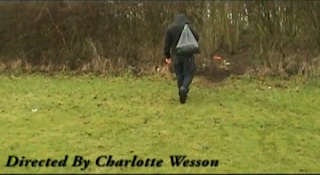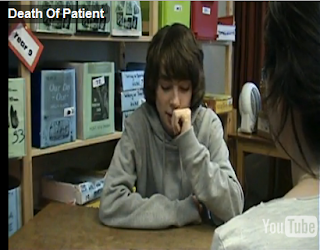With the opening sequence being an essential part of the film, it needs to express certain forms and conventions that establish the genre and narrative.
My opening sequence conforms to the conventions of a ‘real’ media product by:
- Introducing the antagonist, who is clearly identifiable as he is dressed in dark clothing, with his hood up and carrying a black bag, making him look menacing, and the stereotype of what a ‘bad guy’ may be

- Using opening credits
- Creating enigmas, for example the black plastic bag that the male character is carrying throughout the sequence. This is an enigma as the audience are not sure of the contents of the bag, and wish for this to be solved.
- Drawing the audience in
- Using a soundtrack deliberately added to create an eerie atmosphere
These conventions are more commonly seen in thrillers, which is the genre i had chosen to work with.
My opening sequence challenges the conventions of a ‘real’ media product by:
- Filming in naturalistic lighting, and a lighter environment, which is not typical of a thriller
- Using handheld camera
- Using no dialogue
2. How does your media product represent particular social groups?
My film focuses on the younger generation, of teenagers around 13 – 18. I feel the opening does not have a specific social group to focus on; however i feel the film represents more middle-class citizens. I cast Shaun Cutts as the main antagonist as he was readily available and he
3. What kind of media institution might distribute your media product and why?
EM media is the type of institution that i would expect to aid the production of my film by providing sets, casts and funding, however they are not a distribution company. A distributer who may work in conjunction with our film may be Optimum, which works with the film EM media helps. I believe these would be a suitable distribution company as they distribute lower budget films, such as This Is England, which is not a thriller; however has a darker side, much like my film. This darker side is present in the form of the enigmas of the perceived old woman and the black bag.
4. Who would be the audience for your media product?
The initial targeted audience for our thriller was teenagers, both male and female, ranging from the age of around 15 to 18, depending on what age certificate the ‘finished’ film would be. However, i feel my film may appeal to men more, as the thriller genre is often more associated with men, as it is often scary, therefore if you watch them you may be deemed ‘brave’, which is often associated with masculinity. Also, the main character in this film is male, and young, which represents males in a more positive light, therefore men may relate to them more. In contrast, the female character is perceived as old, therefore possibly representing women in a more negative light.
My film would appeal to both male and female adolescents with an obscure taste in films, who enjoy the thriller genre, as i feel it has a niche audience, therefore targeting a specific group of people.
5. How did you attract/address your audience?
We kept to our targeted age bracket using a variety of techniques. One of these techniques being by using camera techniques more commonly used in modern thrillers, which are normally aged at teenagers. Also, the main character is clearly a teenager or young adult. This would also appeal to a teenage audience, more so than an older audience, because they would be able to relate with the main character, and possible understand his actions or intentions.
6. What have you learnt about technologies from the process of constructing this product?
I have learnt that technologies can be unreliable and can disappoint on occasions. For instance, some of our capturing would not work on the computer, yet we did not make any mistakes. Therefore, an error had occurred that we could not fix as we did not know where we went wrong. Also, the sound quality on the camera was not very good when filming in windy conditions, therefore the filming sounded grainy and could not be used in the final product.
7. Looking back at your preliminary task, what do you feel you have learnt in the progression from it to the full product?
I feel that I have learnt the true importance of varying different shots, and making sure that there is more than one take to each scene, as sometimes the shots do not look how you would expect them. Also, i have learnt how to edit more efficiently and professionally using Adobe Premier Pro CS4 compared to my preliminary task, and how to use effects and transitions to enhance the filming.
I have also learnt how to identify continuity errors, therefore making the filming look more professional and avoid losing marks for small errors.
For instance, in my preliminary task i broke the 180 degree rule:

In this shot, it can clearly be seen that the filming is over the male character’s LEFT shoulder, looking at the female character.

However, in this shot, the male character is being filmed over the female character’s LEFT shoulder also, where as it should have been filmed over the RIGHT shoulder.
Although this is only a small continuity error that may be unrecognisable, it does not look as professional, and may lose marks in the actual filming.
I have also learnt how to use effects, shots and transitions appropriate to the genre of the film. For example:
No comments:
Post a Comment